List of German Tank in World War II
2:10 PM
The German Panzer force at the start of World War II was not especially impressive. Only 4% of the defence budget was spent on armoured fighting vehicle (AFV) production. Guderian had planned for two main tanks, the Panzer III was in production but the second support tank with a 75 mm gun was not. Designated the Panzer IV, design work had begun in 1935 and trials of prototypes were undertaken in 1937, but by the time of the invasion of Poland only a few hundred 'troop trial' models were available. The development work was then halted and limited production began by Krupp in Gruson, Essen and Bochum in October 1939 with 20 vehicles built. Even that low number could not be sustained however, production dropping to ten in April 1940. Production was also dropped because metal was very expensive and not many citizens were donating it.
List of German Tank in World War II
1. Panzer I, The first of these German-built tanks was the Panzer I. It was not designed for combat, but rather as a training vehicle to familiarize tank crews with Germany's modern battle concepts, and to prepare the nation’s industry for the upcoming war effort. Nevertheless, the tank design did see actual combat, first during the Spanish Civil War of 1936, then again during World War 2, and elsewhere.
Since the tank was never intended to be used in actual combat, it was plagued by weapon and armour shortcomings through its entire life. Attempts were made to improve the design, but with little success. The Panzer I’s participation in the Spanish Civil war did, however, provide vital information to the German military about modern tank warfare.
| Panzerkampfwagen I | |
|---|---|
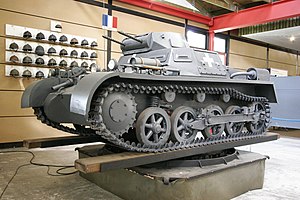 Panzerkampfwagen I Ausf. A on display at the Deutsches Panzermuseum Munster, Germany | |
| Type | Light tank |
| Place of origin | |
| Service history | |
| In service | 1934–1954 |
| Used by | Nazi Germany, Bulgaria, Republic of China, Hungary, Spain |
| Wars | Spanish Civil War, Second World War, Second Sino-Japanese War |
| Production history | |
| Designed | 1934 |
| Manufacturer | Henschel, MAN, Krupp, Daimler |
| Produced | 1934–1936 |
| Number built | 833 |
| Specifications | |
| Weight | 5.4 tonnes |
| Length | 4.02 m |
| Width | 2.06 m |
| Height | 1.72 m |
| Crew | 2; Commander and Driver |
| | |
| Armor | Between 7 and 13 mm |
| Primary armament | Two 7.92 mm MG13 machine guns |
| Engine | Krupp M 305 four cylinder air cooled gasoline engine. 60 PS (59 hp, 44 kW) |
| Power/weight | 11.1 PS/t |
| Suspension | Quarter-elliptical leaf spring suspension. |
| Operational range | 200 km on-road; 175 km off-road. |
| Speed | 50 km/h on-road; 37 km/h off-road. |
2. Panzer II, The Panzer II was ordered into production because the construction of medium tanks, later to be known as the Panzer III and IV, was falling behind schedule. The Panzer II was intended to “fill the gap” until the III and IV could come into full production. Along with the Panzer I, the II made up the bulk of German tank forces during the invasion of Poland and France.
| Panzerkampfwagen II | |
|---|---|
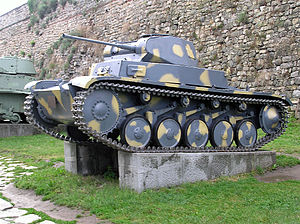 | |
| Type | Light tank |
| Place of origin | |
| Service history | |
| In service | 1936–1945 |
| Wars | Spanish Civil War, World War II |
| Production history | |
| Designed | 1934 |
| Produced | 1935–1943 |
| Number built | 1,856 (excluding conversions) |
| Specifications | |
| Weight | 7.2 tonnes |
| Length | 4.8 m (15 ft 9 in) |
| Width | 2.2 m (7 ft 3 in) |
| Height | 2.0 m (6 ft 7 in) |
| Crew | 3 (commander/gunner, driver, loader) |
| | |
| Primary armament | 1 × 2 cm KwK 30 Ausf.A–f 1 × 2 cm KwK 38 Ausf.J–L |
| Secondary armament | 1 × 7.92 mm Maschinengewehr 34 |
| Engine | 6-cyl petrol Maybach HL 140 hp (105 kW) |
| Power/weight | 15 hp/tonne |
| Suspension | leaf spring |
| Operational range | 200 km (120 mi) |
| Speed | 40 km/h (25 mph) |
3. Panzer III, The Panzer III was intended to be the main medium core of the German armor force when it was designed during the inter-war period. While it was originally designed to fight other tanks, its 37 mm and later 50 mm guns could not keep pace with Soviet T-34 and KV tanks. In 1941, the Panzer III was the most numerous German tank, but by late 1943 it was largely replaced by later versions of the Panzer IV and Panther.
| Panzerkampfwagen III | |
|---|---|
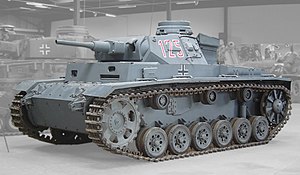 Panzer III Ausf. H | |
| Type | Medium tank |
| Place of origin | |
| Service history | |
| In service | 1939–1945 |
| Used by | Nazi Germany Romania Hungary Independent State of Croatia Turkey Norway |
| Wars | World War II |
| Production history | |
| Designer | Daimler-Benz |
| Designed | 1935-1937 |
| Manufacturer | Daimler-Benz |
| Produced | 1939–1943 |
| Number built | 5,774 (excluding StuG III) |
| Specifications | |
| Weight | 23.0 tonnes (25.4 short tons) |
| Length | 6.41 m (21.0 ft) |
| Width | 2.90 m (9.5 ft) |
| Height | 2.5 m (8.2 ft) |
| Crew | 5 (commander, gunner, loader, driver, radio operator/bow machine-gunner) |
| | |
| Armor | 5–70 mm (0.20–2.8 in) |
| Primary armament | 1 × 3.7 cm KwK 36 Ausf. A-F 1 × 5 cm KwK 38 Ausf. F-J 1 × 5 cm KwK 39 Ausf. J¹-M 1 × 7.5 cm KwK 37 Ausf. N |
| Secondary armament | 2-3 × 7.92 mm Maschinengewehr 34 |
| Engine | 12-cylinder Maybach HL 120 TRM 300 PS (296 hp, 220 kW) |
| Power/weight | 12 hp/t |
| Suspension | Torsion-bar suspension |
| Operational range | 155 km (96 mi) |
| Speed | 40 km/h (25 mph) road, 20 km/h (12 mph) off road |
4. Panzer IV, The Panzer IV was the workhorse of the German tank force during World War II. It saw combat in all theaters, and was the only German tank to remain in production for the entire war.
The Panzer IV was originally intended to be a support tank. It was thus armed with a 75 mm howitzer intended primarily to fire high explosive shells in support of other tanks or infantry. By Mid 1942, it was rearmed with a longer 75 mm dual-purpose gun which could defeat most Soviet tanks. In the second half of the war, about half of all German tanks were Panzer IVs.
| Panzerkampfwagen IV | |
|---|---|
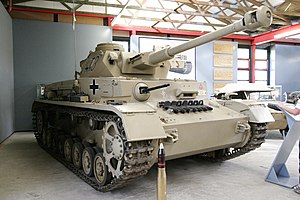 A Panzer IV Ausf G. in desert colors, bearing the palm tree insignia of the 15th Panzer Division of the Afrika Korps. | |
| Type | Medium tank |
| Place of origin | |
| Service history | |
| In service | 1939–1967 |
| Used by | Nazi Germany Romania Turkey Hungary Bulgaria Finland Spain Croatia Syria |
| Wars | World War II, Six-Day War |
| Production history | |
| Designer | Krupp |
| Designed | 1936 |
| Manufacturer | Krupp, Steyr-Daimler-Puch |
| Unit cost | ~ 103,462 Reichsmarks[1] |
| Produced | 1936–45 |
| Number built | 8,800 (estimate) |
| Specifications (Pz IV Ausf H, 1943[2]) | |
| Weight | 25.0 tonnes (27.6 ST; 24.6 LT) |
| Length | 7.02 m (23 ft 0 in) |
| Width | 2.88 m (9 ft 5 in) |
| Height | 2.68 m (8 ft 10 in) |
| Crew | 5 (commander, gunner, loader, driver, radio operator/bow machine-gunner) |
| | |
| Armor | 10–80 mm (0.39–3.1 in) |
| Primary armament | 7.5 cm (2.95 in) KwK 40 L/48 main gun (87 rds.) |
| Secondary armament | 2–3 × 7.92-mm Maschinengewehr 34 |
| Engine | 12-cylinder Maybach HL 120 TRM 300 PS (296 hp, 220 kW) |
| Power/weight | 12 PS/t |
| Transmission | 6 forward and 1 reverse ratios |
| Suspension | Leaf spring |
| Fuel capacity | 470 l (120 US gal) |
| Operational range | 200 km (120 mi) |
| Speed | 42 km/h (26 mph) road, 16 km/h (9.9 mph) off road |
5. Panther Tank, The Panther was a medium tank (45 tonnes) with a crew of five, which was designed to counter the excellent Soviet T-34 tank. In weight it was comparable to US and Soviet heavy tanks. It had sloped armour (for better protection) and carried a long-barreled 75 mm gun. Series production began in 1943 and a total of 4,800 were produced. Initial mechanical problems were mostly fixed, and the Panther is considered the best German tank of the war.
| Panther | |
|---|---|
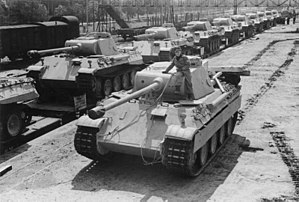 Panther Ausf. D tanks, 1943. The D model can best be recognized by the drum cupola. | |
| Type | Medium tank |
| Place of origin | |
| Service history | |
| In service | 1943–1945 (Nazi Germany) |
| Used by | |
| Wars | World War II |
| Production history | |
| Designer | MAN AG |
| Designed | 1942 |
| Produced | 1942–1945 |
| Number built | about 6,000 |
| Specifications | |
| Weight | 44.8 tonnes (44.1 LT; 49.4 ST) |
| Length | 6.87 metres (22 ft 6 in) 8.66 metres (28 ft 5 in) gun forward |
| Width | 3.27 metres (10 ft 9 in) 3.42 metres (11 ft 3 in) with skirts |
| Height | 2.99 metres (9 ft 10 in) |
| Crew | 5 (Driver, radio-operator/hull machine gunner, commander, gunner, loader) |
| | |
| Armor | 15–120 mm (0.59–4.7 in) |
| Primary armament | 1 × 7.5 cm KwK 42 L/70 79 rounds |
| Secondary armament | 2 × 7.92 mm Maschinengewehr 34 5,100 rounds |
| Engine | V-12 petrol Maybach HL230 P30 700 PS (690 hp, 515 kW) |
| Power/weight | 15.39 PS/tonne (13.77 hp/ton) |
| Transmission | ZF AK 7-200. 7 forward 1 reverse |
| Suspension | double torsion bar, interleaved road wheels |
| Operational range | 250 km (160 mi) |
| Speed | 55 km/h (34 mph) (first models), 46 km/h (29 mph) (later models) |
6. Tiger I, In response to the T-34 after the invasion of the Soviet Union, the German forces ordered the construction of a new heavy tank. Originally to be named the Panzer VI, Hitler ordered the name changed. The tank had formidable firepower and thick armor. It had some mechanical problems due to its weight.
| Tiger Ausf. E | |
|---|---|
 Tiger I in Sicily in 1943 | |
| Type | Heavy tank |
| Place of origin | |
| Service history | |
| In service | 1942–1945 |
| Wars | World War II |
| Production history | |
| Designer | Henschel & Son |
| Designed | 1942 |
| Manufacturer | Henschel |
| Unit cost | 250,800 RM [2] |
| Produced | 1942–1944 |
| Number built | 1,347[Notes 1] |
| Specifications | |
| Weight | 56.9 tonnes or 62.72 tons |
| Length | 6.29 m (20 ft 8 in) 8.45 m (27 ft 9 in) (gun forward) |
| Width | 3.55 m (11 ft 8 in) |
| Height | 3.0 m (9 ft 10 in) |
| Crew | 5 |
| | |
| Armour | 25–120 mm (0.98–4.7 in) |
| Primary armament | 1× 8.8 cm KwK 36 L/56 92 rounds (106 and 120 rounds for some modifications) |
| Secondary armament | 2× 7.92 mm Maschinengewehr 34 4,800 rounds |
| Engine | Maybach HL230 P45 (V-12 petrol) 700 PS (690.4 hp, 514.8 kW) |
| Power/weight | 12.3 PS/tonne |
| Suspension | torsion bar |
| Operational range | 110–195 km (68–121 mi) |
| Speed | 38 km/h (24 mph) |
7. Tiger II, Even larger and heavier than the Tiger I the Königstiger (King Tiger) was the largest and most powerful tank released by German forces during the war. It had the firepower to knock out virtually any allied tank and enough armor to shrug off most allied firepower at the time(excluding hollow charge weapons), but it suffered from multiple mechanical problems due to its rushed development and excessive weight.
| Panzer VI Ausf. B Tiger II | |
|---|---|
 Tiger II preserved at Bovington Tank Museum | |
| Type | Heavy tank |
| Place of origin | |
| Service history | |
| In service | 1944–1945 |
| Wars | World War II |
| Production history | |
| Designer | Henschel & Son / Krupp (turret) |
| Designed | 1943 |
| Manufacturer | Henschel & Son / Krupp (turret) |
| Produced | 1943–1945 |
| Number built | 492 |
| Specifications | |
| Weight | 68.5 tonnes (67.4 LT; 75.5 ST) (early turret) 69.8 tonnes (68.7 LT; 76.9 ST) (production turret) |
| Length | 6.4 metres (21 ft 0 in) 10.286 metres (33 ft 9 in) with gun forward |
| Width | 3.755 metres (12 ft 4 in) |
| Height | 3.09 metres (10 ft 2 in) |
| Crew | 5 (commander, gunner, loader, radio operator, driver) |
| | |
| Armor | 25–180 mm (1–7 in) |
| Primary armament | 1× 8.8 cm KwK 43 L/71 "Porsche" turret: 80 rounds Production turret: 86 rounds |
| Secondary armament | 2× 7.92 mm Maschinengewehr 34 5,850 rounds |
| Engine | V-12 Maybach HL 230 P30 gasoline 700 PS (690 hp, 515 kW) |
| Power/weight | 10 PS/tonne (8.97 hp/ton) |
| Transmission | Maybach OLVAR EG 40 12 16 B (8 forward and 4 reverse) |
| Suspension | torsion-bar |
| Ground clearance | 500 mm (1 ft 8 in) |
| Fuel capacity | 860 litres (190 imp gal) |
| Operational range | Road: 170 km (110 mi) Cross country: 120 km (75 mi) |
| Speed | Maximum, road: 41.5 km/h (25.8 mph) Sustained, road: 38 km/h (24 mph) Cross country: 15 to 20 km/h (9.3 to 12 mph) |